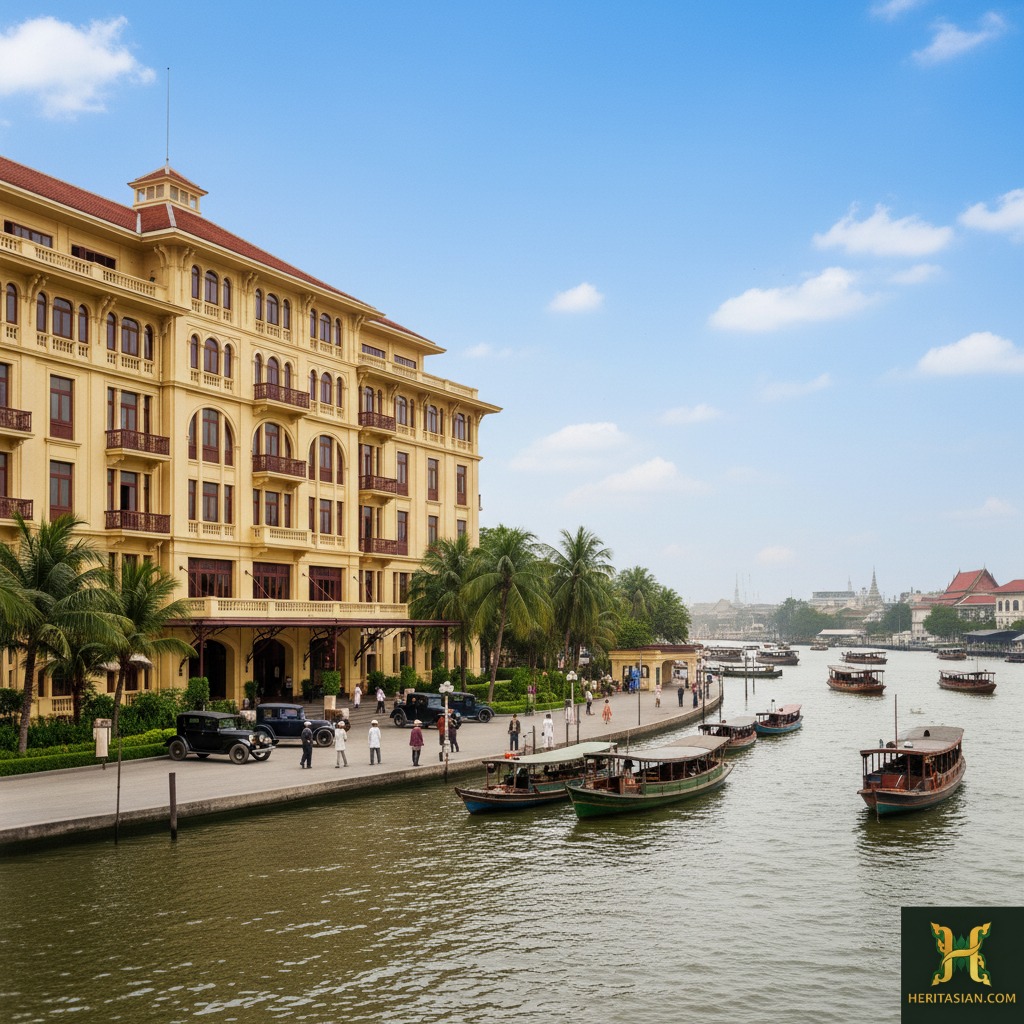The Mandarin Oriental Hotel Bangkok’s history is a tale of a bygone era. Its colonial-era verandahs have, for over a century and a half, seen the fascinating comings and goings of Bangkok royalty and visiting elites.
Since its origin as ‘The Oriental’ in 1876, it holds the distinction of being among the very first hotels built in the Kingdom of Siam. It has earned its stripes as one of Southeast Asia’s most revered heritage hotels.
Founded in 1881 by Danish sea captain Hans Niels Andersen, a riverside boarding house was transformed into a “respectable hotel.” That humble beginning has, over the years, blossomed into a spectacular accomplishment. Now, it stands as a global benchmark for discerning travellers like the readers of Heritasian.com.
For generations, it’s consistently appeared on prestigious “world’s best hotels” lists. Its appeal lies not just in its interiors but in its layers of history embedded within its very walls.
Seafarers’ Haven to Grand Hotel
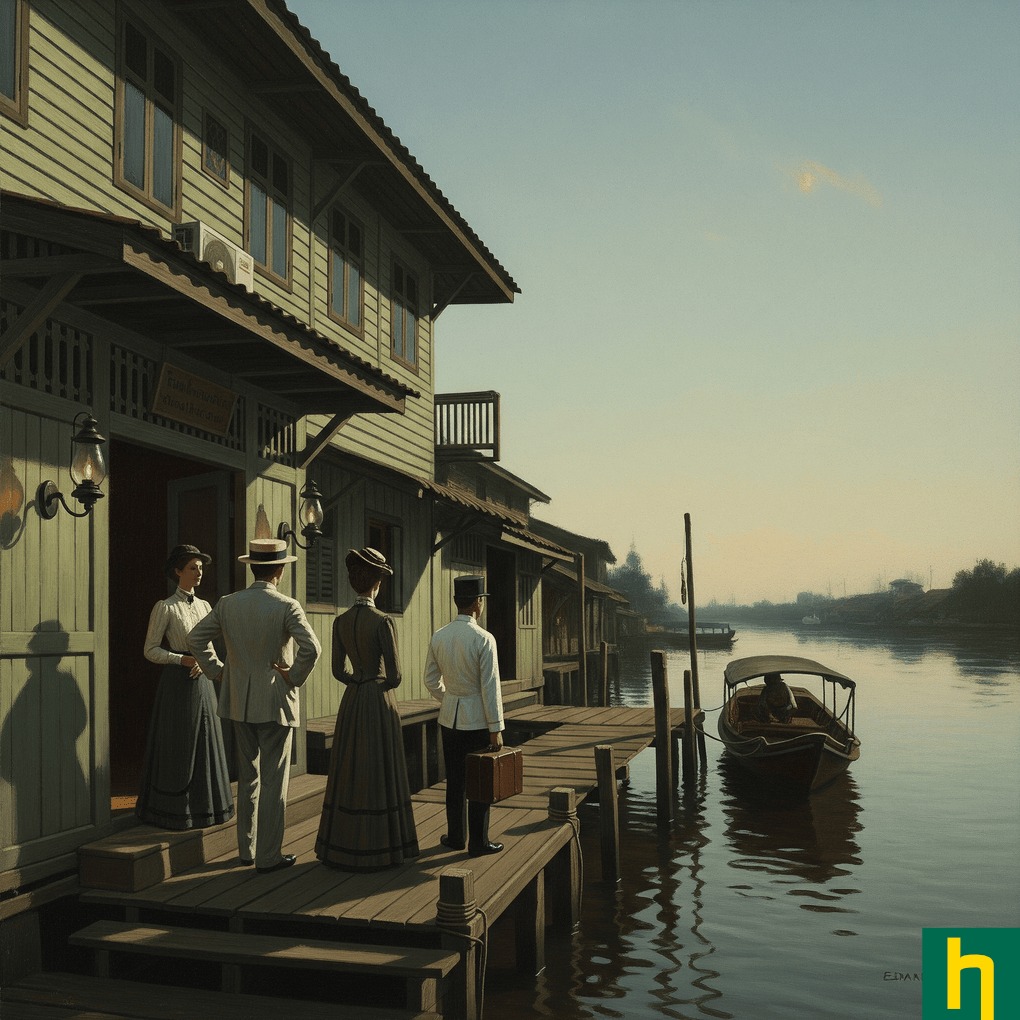
The story begins in the mid-19th century as the Kingdom of Siam opens its doors to foreign trade. European ships docked along the Chao Phraya River. Demand emerged for comfortable lodgings for the growing merchant classes. As was the case in Penang when the Sarkies hoteliers established the E&O in Penang.
The “Oriental Hotel” Concept (1876)
After establishing the powerful East Asiatic Company with partners, Danish sea captain Hans Niels Andersen saw a need beyond mere boarding houses. He dreamt of a place where travellers could find good accommodation, a proper bar, and a menu catering to the Western palate. This culminated in the official establishment of ‘The Oriental’ in 1876.
The First Grand Building
Following a fire in 1886, Andersen and partners decided to create something truly magnificent. They commissioned Italian architects Cardu & Rossi, who delivered a true masterpiece. Opened on May 19, 1887, this new building, now famously known as the Authors’ Wing, was a revelation in Bangkok.
With carpeted hallways, dedicated smoking, ladies’ and billiards rooms, it was all luxury previously unseen outside the royal palaces of Siam. Its dining room was the most elegant in Bangkok.
And soon enough, The Oriental became a glittering social hub, attracting both Europeans and Bangkok’s elite. On May 24, 1888, the hotel hosted a grand banquet celebrating Queen Victoria’s Golden Jubilee, which cemented The Oriental’s status as the premier venue for high society gatherings in old Siam.
A Royal Seal of Approval
The hotel’s growing reputation was brought to the attention of the highest echelons of Siamese society. In December 1890, His Majesty King Chulalongkorn (Rama V) himself paid a private visit, inspecting the facilities with discerning eyes. So impressed was the King that he considered the hotel worthy of hosting royal guests. This led to a momentous occasion in April 1891, when the hotel welcomed its first royal visitor from abroad: Crown Prince Nicholas of Russia, who’d later become the ill-fated Tsar Nicholas II.
The Golden Age: Matriarchs, Monarchs, and Masterpieces
As the 20th century dawned, the Oriental was a flourishing institution. This era saw its transformation into a truly iconic establishment, thanks in no small part to the vision of a remarkable woman, Mrs Marie Maire.
The “Oriental Touch”
The indelible mark of Swiss hotelier Mrs Marie Maire on The Oriental’s legacy can’t be overstated. Arriving in Bangkok at the turn of the century and taking over the management in 1910, Marie Maire was a force of nature. She possessed an unmatched eye for detail and commitment to impeccable service standards. Under her guidance, the hotel’s reputation became synonymous with sophisticated luxury.
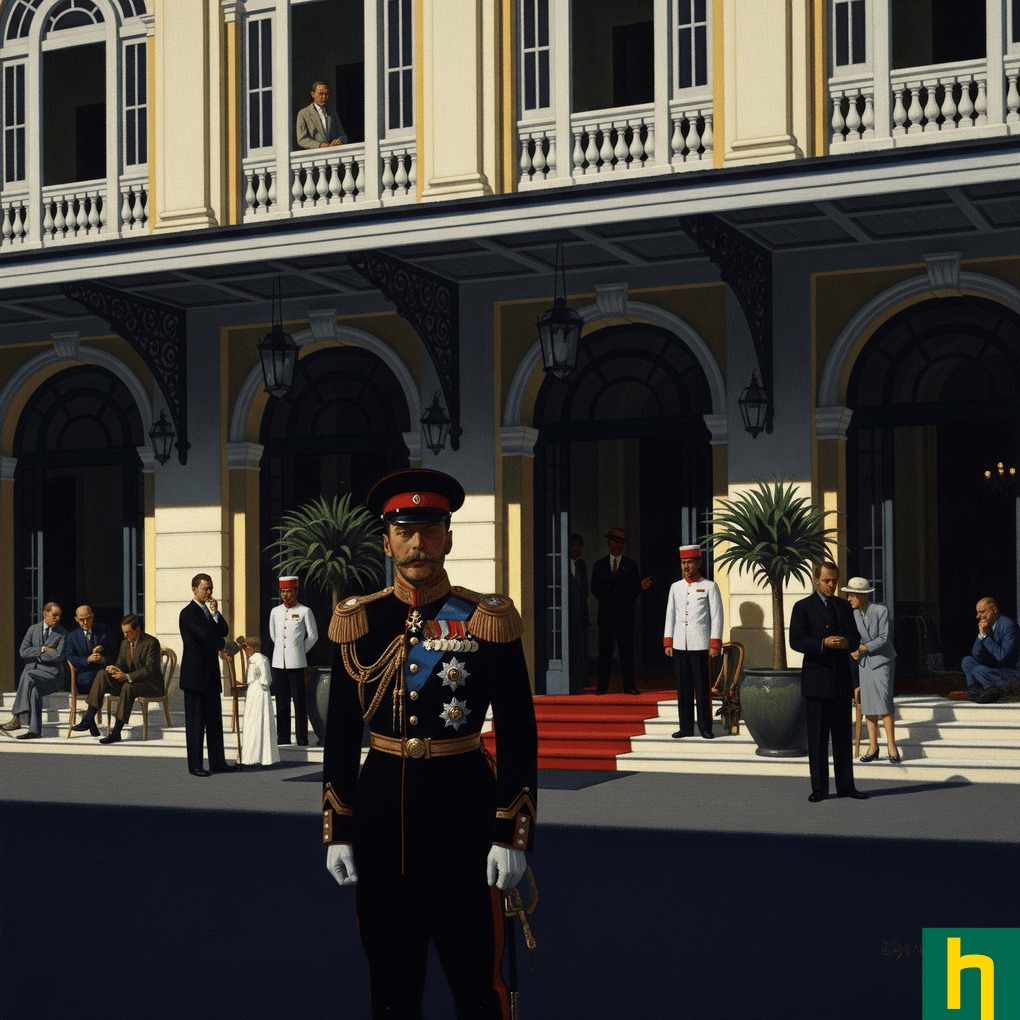
Royal Connections and Diplomatic Grandeur
The strong bonds forged with the Siamese Royal Family saw The Oriental become the place for royal banquets, state dinners, and diplomatic receptions.
King Vajiravudh (Rama VI), in particular, frequented the hotel, appreciating all of its finery. It wasn’t uncommon for foreign dignitaries to reside at The Oriental. These associations elevated the hotel. Far beyond a mere commercial enterprise, it became a symbol of Siam’s growing engagement with the wider world.
A Literary and Artistic Salon
The Oriental Hotel cultivated an intellectual and artistic milieu. Its riverside spot and atmosphere of understated elegance attracted an array of writers, adventurers, and artists.
W. Somerset Maugham, who stayed in 1923, cemented the hotel’s literary legend. Recovering from illness, he found solace crafting stories that depicted the mystique of the East. While the “Authors’ Wing” as a formally named section would come much later, these early literary links laid the groundwork, transforming the hotel into a source of creative inspiration.
Resilience Through Tumultuous Times
The early 20th century saw The Oriental ascend to the pinnacle of Asian hospitality. But it wasn’t immune to the shifts in global geopolitics. The middle decades of the century brought challenges, forcing the hotel to demonstrate a resilience as remarkable as its grandeur.
Navigating World Wars and Political Upheaval (1914-1945)
The two World Wars cast a long shadow over the international luxury hospitality industry. During World War I (1914-1918), the flow of European travellers dwindled significantly. Revenues declined, and the hotel faced the harsh realities of reduced bookings. While not on the front lines, the global conflict meant survival rather than flourishing expansion.
Then came World War II (1939-1945). Following Japan’s invasion of Thailand in December 1941, the country was now under Japanese occupation. The hotel was leased to the Imperial Japanese Army and became an officers’ club.
Oh, how much the contrast: the elegant halls once filled with European aristocrats and literary figures; now under military command and serving a far more austere purpose.
Post-War Revival
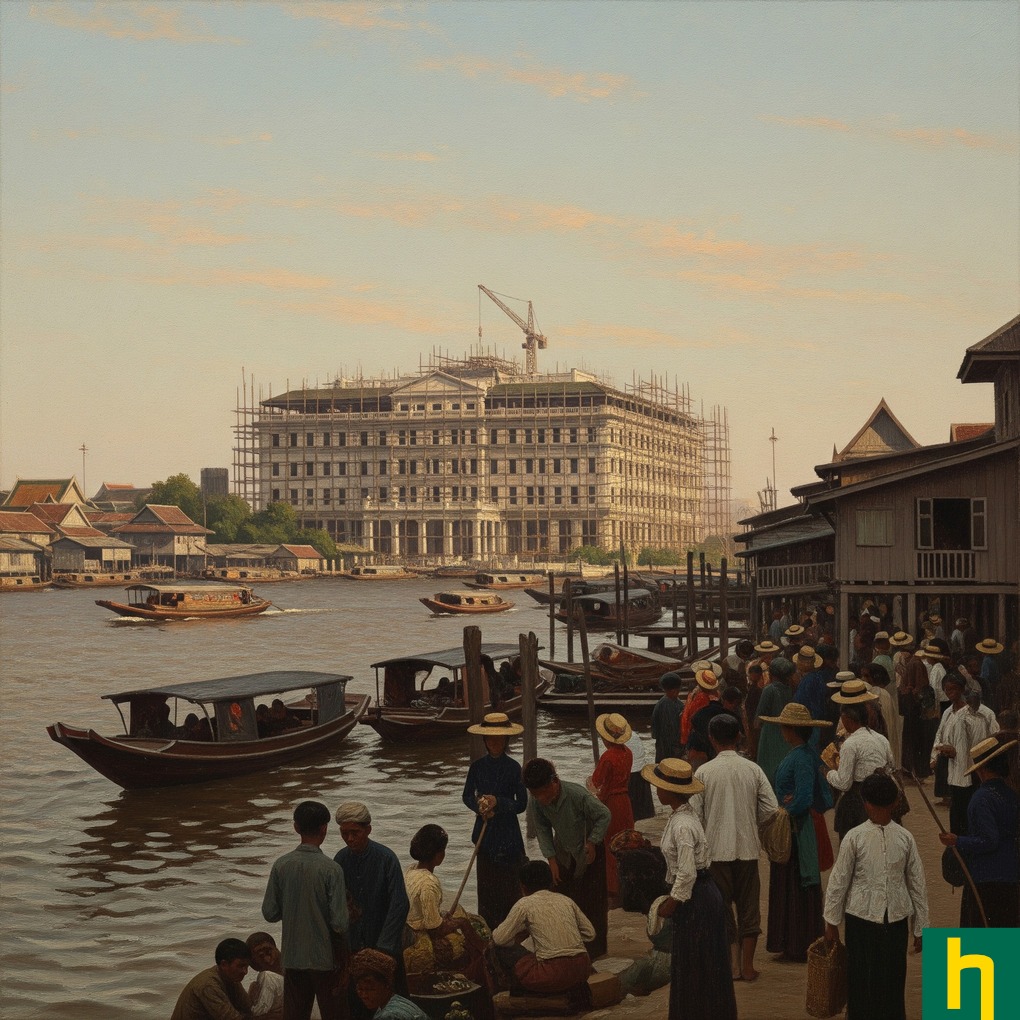
The end of the war brought liberation, but also a badly rundown hotel. Yet, the spirit of The Oriental was continued.
A pivotal moment arrived when a visionary group of six nearby residents, recognising the hotel’s intrinsic value, contributed a sum of just US$250 each to buy the hotel. Their belief marked the beginning of The Oriental’s journey towards a new commitment to its pre-war excellence.
Under new ownership, significant efforts were made to restore the property. The focus was on modern conveniences to cater to a changing world of travel. This period saw the gradual re-establishment of its reputation for service, as Thailand, now an independent nation, embraced a future of growing international tourism. These post-war decades laid the essential groundwork, ensuring that The Oriental would emerge from the shadows of conflict ready for its next, most celebrated, chapter.
The Mandarin Connection
Emerging from post-war recovery, The Oriental was poised to not only restore its former glory but propel it onto the global stage as a benchmark for ultra-luxury hospitality.
Acquisition by Mandarin International Hotels (1974)
The year 1974 marked a truly transformative moment. Mandarin International Hotels, an ambitious group founded with the opening of the Mandarin Hotel in Hong Kong in 1963, recognised the potential in Bangkok’s legendary riverside hotel. They acquired a significant 49% interest and began a strategic partnership that would eventually see the two icons merge to form the Mandarin Oriental Hotel Group. The investment brought crucial capital but also global marketing reach and a shared vision.
Monumental Renovations and Expansions
With new backing, The Oriental embarked on an expansion program, dramatically reshaping its offerings. The most striking addition was the River Wing, completed in 1976, a towering modern structure that much increased the hotel’s room capacity. This project, costing 300 million Thai baht, was a statement of confidence in Bangkok’s growing tourism industry. It introduced larger swimming pools, world-class kitchens, and new dining venues, while still ensuring breathtaking views of the Chao Phraya.
The existing structures were meticulously upgraded. The Garden Wing was refurbished, offering suites with private balconies overlooking lush landscapes. This period also saw the enhancement of its dining experiences, such as the renowned Le Normandie, offering exquisite French haute cuisine. And the Sala Rim Naam, where traditional Thai performances were accompanied by authentic Thai dishes, as diners overlooked the river. The Oriental Spa, which officially opened in 1993, began to take shape as a pioneering urban sanctuary for wellness, drawing on ancient Thai healing traditions.
Preserving the Past
Yet amidst all the modernisation, the management demonstrated a strong commitment to preserving the hotel’s historical heart. The original 1887 building, the very soul of The Oriental, wasn’t only maintained but celebrated. It was during this era that the beloved Authors’ Wing was formally named and lovingly curated. Each suite within this historic wing is now dedicated to the literary giants who stayed there.
The Authors’ Lounge, complete with white wicker furniture and lush greenery, became a living museum, adorned with photographs and memorabilia, serving as a tranquil space for afternoon tea. This blending of historical elegance with contemporary luxury has become a signature element of the Mandarin Oriental, Bangkok.
The Modern Mandarin Oriental Bangkok
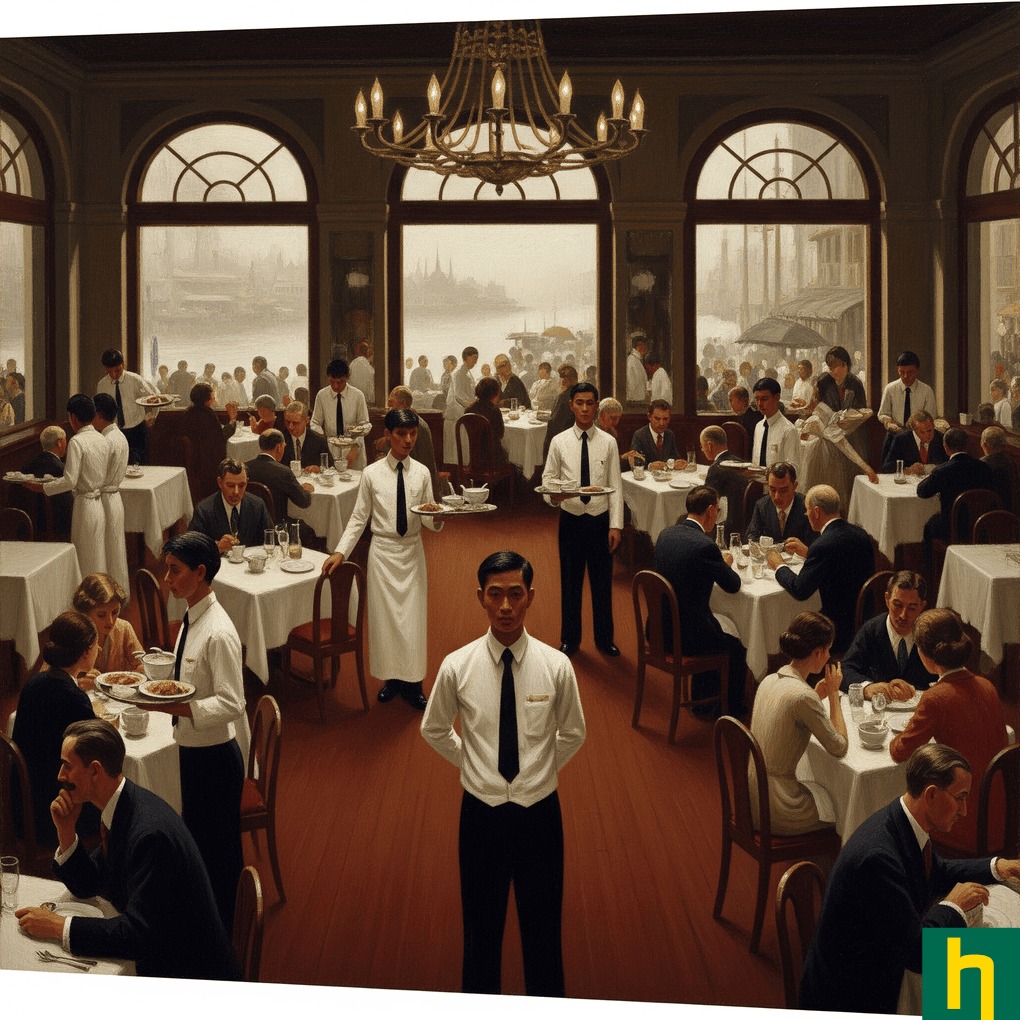
With its grand expansions complete and its heritage lovingly restored, The Mandarin Oriental, Bangkok entered a new epoch. It cemented its status not just as a leading hotel in Asia but as a global icon of luxury hospitality. This period saw a relentless pursuit of perfection, a commitment to cultural ambassadorship, and an integration of tradition with the demands of the modern age.
The “Oriental Standard”
At the heart of the modern Mandarin Oriental, Bangkok, lies its legendary “Oriental Service.” Not just a corporate slogan, but a core philosophy. This commitment translates into an almost clairvoyant ability to anticipate guests’ needs. There are stories of staff recalling a guest’s favourite flower, morning newspaper, or even a specific pillow type from a visit years before. This attention to detail and a staff-to-guest ratio above industry norms are hallmarks of the ‘Oriental Standard’.
This commitment extends to every facet of the guest experience. Le Normandie by Alain Roux, for instance, has long held a coveted two Michelin stars, continuing its legacy as a bastion of French haute cuisine in Southeast Asia. And the hotel’s famed Oriental Thai Cooking School, established in 1986, invites guests to delve deeper into the intricacies of Thai gastronomy.
Cultural Ambassador and Global Benchmark
The Mandarin Oriental Hotel Bangkok transcended its role as a mere place of lodging; it’s become a cultural ambassador for Thailand itself. Its guest roster reads like a who’s who of global influence. Famous anecdotes include the elaborate security arrangements for visiting U.S. Presidents or the discreet stays of global pop stars seeking sanctuary from the limelight. High-profile visits not only underscore its elite status but also highlight its critical role in international relations and cultural exchange.
Beyond its VIP list, the hotel actively promotes Thai arts and culture. The elegant Sala Rim Naam not only serves authentic Thai cuisine but also hosts classical Thai dance performances nightly. The hotel’s curated art collection reinforces its dedication to showcasing Thailand’s rich heritage.
Adapting to the Future and Honouring the Past
In an ever-evolving hospitality landscape, The Mandarin Oriental, Bangkok balances its cherished traditions with the demands of modern luxury – somewhat like the spirit of Thai people themselves.
With its dedication to unparalleled service and a deep respect for its illustrious past, The Mandarin Oriental, Bangkok remains not just relevant but continuously at the pinnacle of luxury hospitality.
The Mandarin Oriental on the Chao Phraya River
The Mandarin Oriental Bangkok’s history starts with pioneers like Hans Niels Andersen and the indomitable spirit of Mrs Marie Maire. It’s the chronicle of a building that weathered two World Wars and immense political shifts, serving as an officers’ club in one chapter and a beacon of post-war recovery in the next. And it’s the story of its strategic alliance with Mandarin International Hotels in 1974, a partnership that ushered in an era of expansion and a preservation of its cherished heritage under the Mandarin Oriental Hotel Group.
It’s been the discreet backdrop for countless pivotal moments, from royal visits to the quiet solace sought by W. Somerset Maugham. Its commitment to the “Oriental Service” standard continues to define it, creating unforgettable experiences at one of the world’s most famous hotels.
As you’ve journeyed through the history of the E&O, from its legendary beginnings to its enduring grandeur, perhaps you’re now envisioning your chapter within its storied walls. Discover how you can experience this iconic piece of heritage and hospitality firsthand.
Mandarin Oriental Bangkok History FAQs
When was the Mandarin Oriental, Bangkok originally founded?
The Mandarin Oriental, Bangkok, originally opened as The Oriental in 1876. It is a historic luxury hotel and holds the distinction of being the first hotel built in Thailand (then known as Siam) on the banks of the Chao Phraya River.
What historical wing of the hotel is most famous for its literary connections?
The Authors’ Wing is the most famous historical part of the hotel, renowned for hosting and inspiring world-famous writers. It was built in 1887 and has hosted literary legends like W. Somerset Maugham, Joseph Conrad, and Noel Coward, cementing the hotel’s legendary literary status.
What is the significance of the hotel’s name change from “The Oriental” to “Mandarin Oriental”?
The name change occurred in 1985 after Mandarin International Hotels acquired a 49% stake in the hotel in 1974. The two flagship properties, “The Mandarin” in Hong Kong and “The Oriental” in Bangkok, merged their names to form the Mandarin Oriental Hotel Group, representing a blend of Asian heritage and luxury hospitality.
What are some of the historical “firsts” attributed to the Mandarin Oriental, Bangkok?
As the city’s first luxury hotel, it pioneered several innovations, including being the first on the Chao Phraya riverfront, the first to have a jazz bar (the iconic Bamboo Bar), and the first to offer a hotel spa in Thailand, establishing itself as a leader in refined hospitality.
What is the Mandarin Oriental, Bangkok’s relationship with Thai royalty and famous guests?
The hotel has a deep historical connection with Thai royalty, with King Chulalongkorn (Rama V) personally inspecting the hotel in 1890 to ensure it was suitable for visiting dignitaries. It has since become a favoured destination for global royalty, heads of state, and countless celebrities, earning its nickname as the “La Grande Dame of Bangkok.”

